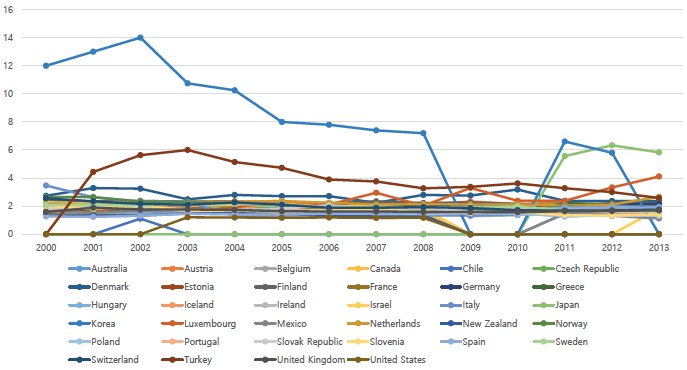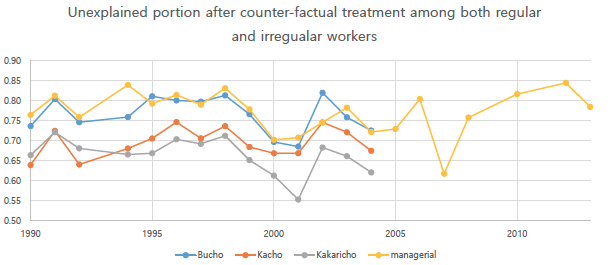Japan and South Korea are distinctive among developed countries for their gender inequality in managerial positions. This column looks at the ‘glass ceiling’ in the two countries. After controlling for age, education, and employment duration, between 70% and 80% of the gender disparity is unexplained in both countries, with women appearing to face greater inequality as they move up to more senior managerial positions.
Although Japan and South Korea are among the most developed countries in East Asia, it is well known that traditional gender role attitudes and behaviours still exist in both countries. According to International Labor Organization statistics for 2015, Japan and Korea showed the highest gender inequalities in the proportion of managerial positions among OECD countries (ILO 2015). Figure 1 reveals that Japan and Korea are distinctive among OECD countries as having the highest gender inequalities.

Depending on the sources of the disparity, the strategy for improving gender inequality should be quite different. If human capital, such as education and experience, is the basis of the inequality, we should launch policies to improve the accumulation of the human capital of women. However, if the source is not a human capital gap but a glass ceiling, we want to examine and change promotion practices in firms.
The existence of glass ceilings?
The glass ceiling phenomenon refers to an invisible ceiling blocking the entry of women into high-level positions in firms or organisations. There have been many empirical studies examining glass ceilings in various countries. For the US, many studies confirmed that gender inequality does not increase as women advance to more senior positions in a firm, and thus could not find the existence of a glass ceiling (Morgan 1998 Weinberger 2011 Wright et al. 1995). Since the findings of Morgan's research in 1998 strongly suggested that the higher inequality among women in more senior positions (and thus among older women) resulted not from a glass ceiling but from cohort differences (i.e. higher gender inequality among older cohorts), many following studies have confirmed limited instances of a glass ceiling in the US. Weinberger (2011) concluded that the gender gap in earnings is determined by factors already present early on in careers. Also, Wright et al. (1995) found little evidence for the glass ceiling hypothesis—i.e. that barriers to promotions for women in authority hierarchies are greater than the ones they face in getting into hierarchies in the first place—in seven countries (the US, Canada, the UK, Australia, Sweden, Norway, and Japan).
However, more recent studies show possible support for the glass ceiling hypothesis in Europe. Albrecht et al. (2003) successfully showed that even after extensive controls for gender differences in age, education, sector, industry, and occupation, a glass ceiling effect was persistent to a considerable extent in Sweden. Also, a study examining 11 European countries using the European Community Household Panel from 1995 to 2001 found that the gender gap in earnings typically widened towards the top of the wage distribution, which strongly suggests the existence of a glass ceiling (Arulampalam et al. 2007). We do not have consistent evidence for European countries yet, but more recent data and studies tend to confirm the existence of glass ceilings in Europe.
Measuring the glass ceiling in Japan and South Korea
How about Japan or Korea? Wright's et al.'s study in 1995, which examined the glass ceiling effect among seven countries including Japan, confirmed that gender inequality in workplace authority was highest in Japan. However, they could not test for the glass ceiling effect in Japan because there were no women in middle management positions or above among 823 Japanese respondents. There has been little research on a Korean glass ceiling using reliable data based on robust methods.
Our study tries to compare the extent of the glass ceiling in Japan and Korea based on a common statistical method (Youm and Yamaguchi 2016). First, we have to decide how to measure the glass ceiling. Previous studies have not all employed the same operational definition of a glass ceiling. For example, Barretto et al. (2009) examined the gender gap in only the most senior positions, while other researchers probed the slowing down of the entire career progress of typical working women (Padavic and Reskin 2002). Although the empirical criterion for more senior positions in organisations could be different, we believe the minimum proposition of the glass ceiling hypothesis is that after controlling for human capital factors, the gender gap becomes wider in more senior positions.
Also, in order to control for human capital such as age, educational level, and employment duration, we adopt the counter-factual decomposition method of DiNardo-Fortin-Lemieux (DFL) proposed in Yamaguchi (2016, 2017). We used the Occupational Wage Survey (OWS) to examine the glass ceiling in South Korea. The OWS is an annual business establishment survey conducted since 1970 by South Korea's Ministry of Employment and Labor. We included multiple-year cross-sectional data over a 24-year period from 1990 to 2013 to examine the trend for a glass ceiling in Korea. The International Comparative Study of Work-Life Balance conducted by RIETI in 2009 was employed to examine the Japanese gender gap. Unlike the 20+ years of data for South Korea, we analysed one year of data of 2009 for Japan.
The glass ceiling in Japan and South Korea
In Japan, even after conducting a counter-factual treatment with age, education, and employment duration, the unexplained portion of gender disparity still remains at between 70% and 80% for 2009. Also, as we move from kakaricho (task unit supervisor) position to kacho (section head), we can see a roughly 10% bigger unexplained portion. Although we could not examine the bucho (department director) position since we do not have enough female bucho in the data, the current result implies a possible glass ceiling or pipe leaking even from the middle manager positions among regular worker in Japanese firms.
Figure 2 illustrates the trend for a glass ceiling in Korea over 24 years.

Three facts are revealed from the figure. First, the unexplained portion after a counter-factual treatment for human capital including age, duration of employment, and educational level, the range of unexplained gender inequality for managerial positions falls between 75% and 85%, except in 2007 when the portion was 62% (yellow line). This is corresponds somewhat to the Japanese unexplained portions, which are 70% for kakaricho and 80% for kacho. Since Korean managerial positions include bucho and higher, the numbers seem strikingly similar.
Second, as women reach higher positions in a firm—from kakaricho (grey line) to kacho (orange line) to bucho (blue line)—they face a higher unexplained portion, just like Japanese women. This fits the glass ceiling picture quite closely, although we do not have data for very senior managerial positions.
Although we have only one year of data for Japan and are thus not completely confident in the comparison, the extent of unexplained gender inequality seems to be strikingly similar in the two countries. Furthermore, in both countries, women seem to face greater inequality as they move up to more senior managerial positions (i.e. glass ceilings). Based on multiple cross-sectional data over 24 years, we can also conclude that the extent of the glass ceiling tends to remain the same in Korea. We suspect that this is not due to simple cohort differences as argued by Morgan (1998), but to an actual glass ceiling because our data ranges over 24 years and show little changes (i.e. little difference between cohorts).
Editors' note: The main research on which this column is based appeared as a Discussion Paper of the Research Institute of Economy, Trade and Industry (RIETI) of Japan.
This article first appeared on www.VoxEU.org on December 11, 2016. Reproduced with permission.



